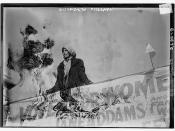The Domestication of Wheat
Ten thousand years ago as the gigantic glaciers of the last ice age (Pleistocene Epoch) receded, the Earth's atmosphere warmed and stabilized (World Book 6). Human beings discovered that with this new atmosphere animals and plants were available year around in a singular location and they no longer had to travel great distances to acquire needed foods. This was the birth of civilizations and thus agriculture (Kolbert 31). Around the same time many plants, some old and some new, started to sprout up around the world. One of these plants was Einkorn.
People started to domesticate plants and livestock because of a coincidental combination of events. Populations of tribes were growing at very rapid rates, making it harder for them to travel long distances. Soon after being forced to settle down in one area, the amount of food available began to dwindle. The people had to find alternatives to hunting and gathering as their primary way of getting food (Wyse 78).
So they began to grow desired plants in controlled environments. They made tools to help in the systematic planting and harvest of these plants. The tools for the most part were limited to carved sticks and shaped rocks. But over time advanced tools like the plow were developed to help increase the amount of food that could be produced (Gras 389).
People also started to domesticate plants and animals because for the first time since modern man the climates permitted it. Up until this time the atmosphere was quite cold and weather patterns changed almost annually. But the Earth was warming up and since most of the people were living towards the equator--due to the glaciers--the temperature fluctuated very little (World Book 6). This made more consistent weather patterns, and thus wildlife would remain in...


